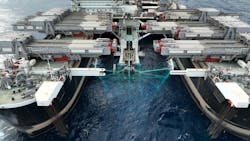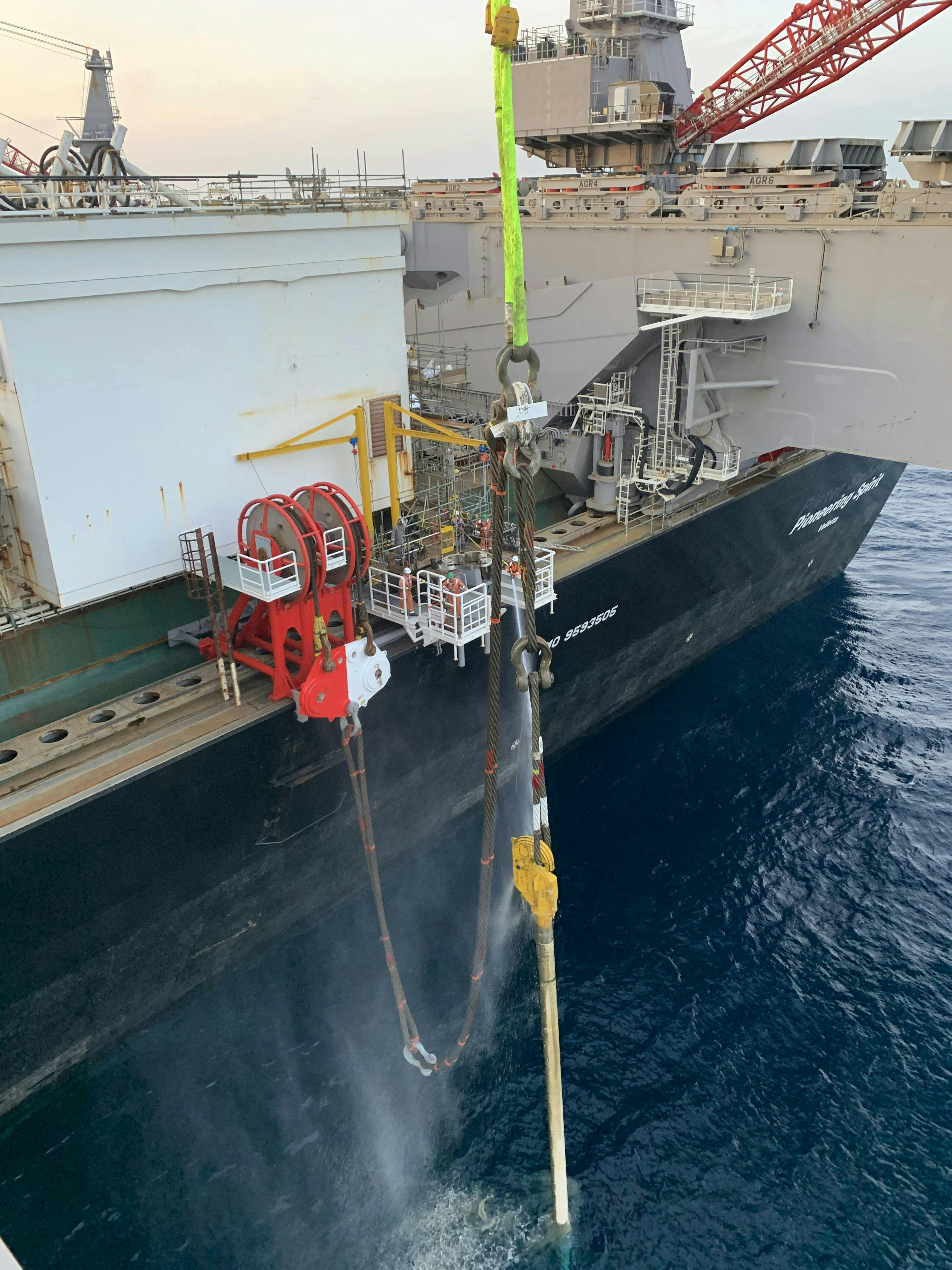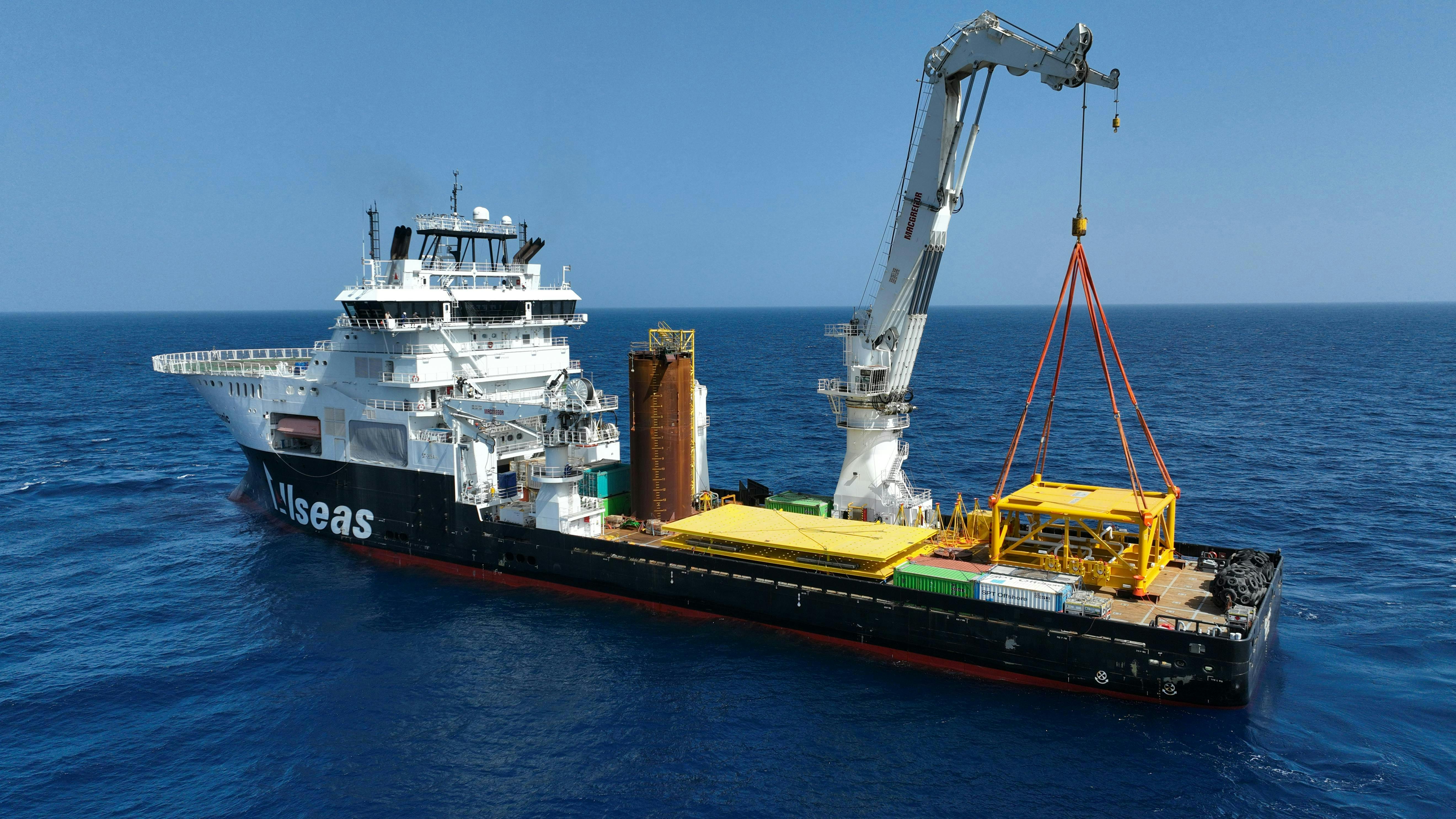Pioneering Spirit picks up the reins for GTA deepwater pipelay
Editor's note: This feature first appeared in the July/August 2024 issue of Offshore magazine.
By Jeremy Beckman, Editor, Europe
Allseas’ Pioneering Spirit has performed its first pipelay assignment offshore West Africa, in unusual circumstances. The vessel, originally designed for S-lay operations, had undergone a fast-track adaptation to J-lay mode to complete the final sections of the Greater Tortue Ahmeyim (GTA) phase 1 project pipelines offshore Mauritania and Senegal. Operator bp approached Allseas to see if it could provide assistance, following delays to the subsea installation scope.
According to Laurent Beghin, Allseas Project Manager for GTA: “Although the two companies had not worked together for some time, bp quickly realized Allseas had the right assets and expertise to execute the outstanding scope of the GTA1 project. Pioneering Spirit was more than capable of doing the job and was available in the period bp had identified for completion of the remaining scope. The vessel required an upgrade with a 1,000-metric ton [984-ton] J-mode portal frame, but other than that she was ready to go.”
The first phase of the GTA development is in water depths of up to 2,850 m (9,350 ft), the deepest of any greenfield project off West Africa to date. The subsea production system will tie back four first- gas wells to an FPSO via two parallel 80-km (49.7-mi), 16.75-in. pipelines. From the FPSO, production will then head through a separate export pipeline, installed by another contractor, to the FLNG Gimi at the shallow-water nearshore GTA Hub.
For Allseas, there was a unique challenge in that there were 20.2 km (12.5 mi) remaining on the deepwater south line and 47.2 km (29.3 mi) remaining on the north line. “We had to recover both lines, which had been left unfinished on the seabed by the previous contractor,” said Beghin, “and then resume pipelay in S-lay mode.”
All the pipes were manufactured by Sumitomo, and the 10.75-in flowlines were made entirely from a Corrosion-Resistant Alloy (CRA), comprising 3.0 mm of Inconel added to 19.0 mm of carbon steel. The four infield lines were relatively short: A02, the longest was 2,970 m (9,744 ft) long, while A01 and A04, respectively 1,030 m (3,379 ft) and 1,880 m (6,168 ft), were both shorter than the water depth in which they had to be installed. The 16.75-in. pipelines also had a 1,350-m (4,429-ft) section of CRA pipes (28.5 mm of carbon steel and 3.0 mm of Inconel) towards the deepwater manifold end, while the remaining length of pipelines were 32.0 mm-thick carbon steel pipes.
MODIFIED ASSEMBLIES
For the initial two-month engineering phase, Allseas established two teams of engineers and draftsmen, with additional support from the company’s Heavy Lift division. The GTA pipeline system and appendages had been designed for J-mode configuration. As Allseas installs in S-mode, the structural engineering group company would need to modify the 10 x 80-mt (9.84 x 78.7-t) flowline termination assemblies (FTAs) – otherwise known as pipeline end terminations (PLETs) – to be in line with the installation procedure. This work would include strengthening the yokes for the 10-in. FTAs and building new yokes for the 16-in. versions.
“The pipe walking mitigation clamps had to be relocated closer to the FTAs so they too could be installed in J-lay mode,” Beghin explained. “We needed to design, build and install roller guides to ensure the integrity of the corrosion monitoring system when going over the roller boxes in the firing line and over the stinger. Further engineering was needed to confirm the feasibility and to ensure that the CMS would be safely landed on the seabed.
“In parallel, the group had to engineer, construct and install Pioneering Spirit’s new aft portal J-frame within a few weeks, to enable hook-in and out the pre-installed pipelines and attachment of the modified FTAs. Allseas Engineering used an existing design (Solitaire and Audacia are fitted with similar J-frames), which was approved by Lloyd’s Register as ‘any ancillary equipment added to our vessel’. We did, of course, perform installation checks and also engineered the different steps of the FTAs installation. Being able to do all those different steps in-house again was a key enabler to this project. Once the design was finalized, construction started at the Allseas Fabrication B.V. (AFBV) yard in Heijningen, the Netherlands.” The same yard also modified the 10 subsea structures, each weighing around 80 mt (78.7 t), which were shipped from Nouakchott, Mauritania to Rotterdam for the necessary work.
Despite the time pressures and challenges with materials availability, AFBV managed to source the plate steel for the portal frame and hang-off frame fabrication, including H-beams, from various locations around Europe. The portal frame (including aft support and sheaves) measured 7.4 m x 3.8 x 6.3 m (L x W x H, 24.3 x 12.5 x 20.7 ft) and weighed 48 metric tons (77.2 tons), while the 26-mt (25.6-t) hang-off frame measured 6.6 x 2.5 x 3.3 m (21.6 x 8.2 x 10.8 ft). The J-mode portal frame had to be installed before Pioneering Spirit’s contracted departure from Rotterdam on November 15, 2023, and the (first batch of four) FTAs also needed to be ready by that date. In an attempt to speed up the process Allseas hired a coating company to work outside the production site in Heijningen; however, persistent rain at times meant that some of the coating scope had to be performed by Allseas crew on board during transit to Senegal.
The extreme water depths for the GTA campaign would require a modified suction pile to provide sufficient holding capacity during pipeline start-up and structure installation. The solution was to create a 15-m (49-ft) tall suction pile from two existing piles, with the modification managed at the company’s yard in Rotterdam. “Some items required modification to ensure they were fit for purpose. Other parts of the fabrication scope were outsourced, mainly installation aids, which were handled by Europoort, a partner of Allseas located in Rotterdam. The long working relationship was also a key differentiator in making this subcontracted fabrication scope a success. Everything was delivered to Allseas and bp’s satisfaction and on time.”
EXTENDED CABLE
“The company did not have to set up a local logistics base for this project; bp managed the yard in Nouakchott where all the 16.75-in. pipes remained. And the 10.75-in. infield pipes had been shipped to Rotterdam before Pioneering Spirit set sail, allowing the crew to start double jointing during transit to the field.
“The vessel had never worked in West Africa before, so our installation engineering and naval departments had conducted a thorough analysis to ensure the best workability configurations for this project. In the event, the vessel performed as planned, with not a single hour waiting on weather. The lay rate for the 10.75-in. CRA flowline was 1 km [0.62 mi] over a period of 24 hr, and 1.4 km/24 hr [0.87 mi] at peak, which was above expectations. This was due in large part to the company’s in-house automated welding system ‘Phoenix’ which includes automated seam tracking and height control, both paramount to proper position weld puddle in narrow grove welds. Welding parameters can be set for each clock position and locked during production to ensure welding within qualified parameter ranges.”
There were other issues to negotiate along the way, notably installation of the two shorter flowlines, with an FTA at each end. This involved hooking in and out on a pre-installed suction pile in ultra-deepwater, then landing one end on a temporary location on a temporary mudmat before installation of the second end’s FTA could begin. But despite the long Atlantic swell causing the vessel to roll continuously, there was no break in production for weather. All work was completed on February 23, 2024, 10 days ahead of schedule.
“This was a first for Pioneering Spirit,” said Beghin. “She demonstrated how effective she was in this area of the world and will undoubtedly return there for future work. And now the vessel is fitted with a J-frame, we can offer her services to other customers asking for J-lay work, in addition to S-lay installation of pipelines.”
About the Author
Jeremy Beckman
Editor, Europe
Jeremy Beckman has been Editor Europe, Offshore since 1992. Prior to joining Offshore he was a freelance journalist for eight years, working for a variety of electronics, computing and scientific journals in the UK. He regularly writes news columns on trends and events both in the NW Europe offshore region and globally. He also writes features on developments and technology in exploration and production.



